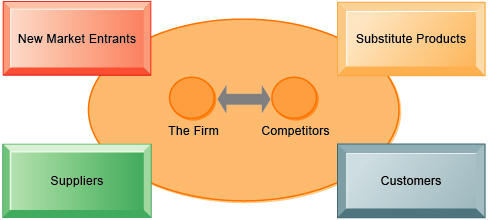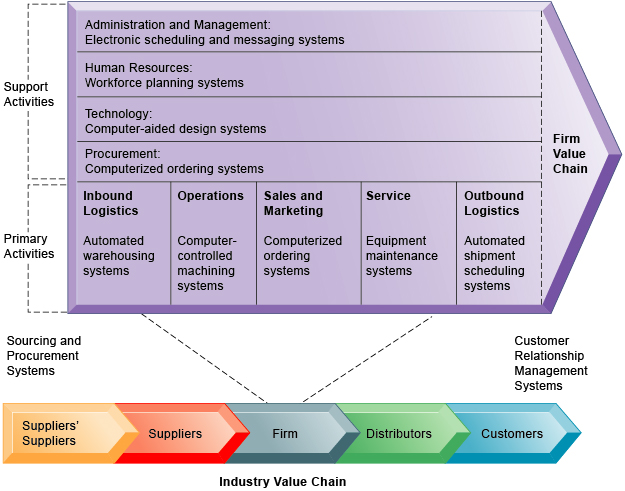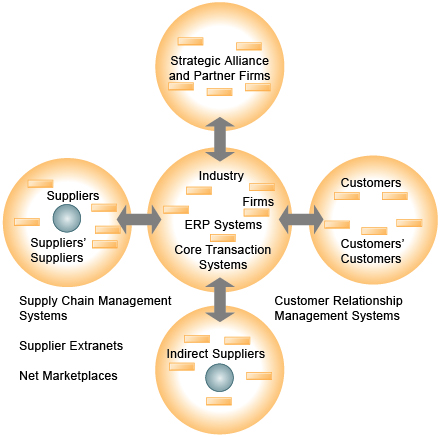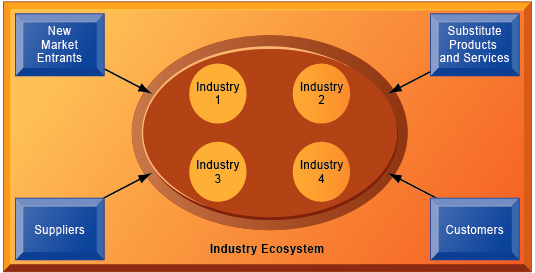| Section 3.3: Bullet Text Study Guide |
Using Information Systems to Achieve Competitive Advantage
Firms with a competitive advantage over others typically have access to special resources that others do not or are able to use resources more efficiently, resulting in higher revenue growth, profitability, or productivity growth (efficiency), all of which ultimately in the long run translate into higher stock market valuations than their competitors.
Michael Porter's competitive forces model describes five competitive forces that shape the fate of the firm.
- Traditional competitors: Existing firms that share a firm's market space
- New market entrants: New companies have certain advantages, such as not being locked into old equipment and high motivation, as well as disadvantages, such as less expertise and little brand recognition. Some industries have lower barriers to entry, ie: cost less for a new company to enter the field.
- Substitute products and services: These are substitutes that your customers might use if your prices become too high. For example, Internet telephone service can substitute for traditional telephone service. The more substitute products and services in your industry, the less you can control pricing and raise your profit margins.
- Customers: The power of customers grows if they can easily switch to a competitor's products and services, or if they can force a business and its competitors to compete on price alone in a transparent marketplace where there is little product differentiation and all prices are known instantly (such as on the Internet).
- Suppliers: The more different suppliers a firm has, the greater control it can exercise over suppliers in terms of price, quality, and delivery schedules.
Figure 3-10
 |
|
There are four generic strategies used to manage competitive forces, each of which often is enabled by using information technology and systems:
- Low-cost leadership: Use information systems to achieve the lowest operational costs and the lowest prices. For example, a supply chain management system can incorporate an efficient customer response system to directly link consumer behavior to distribution and production and supply chains, helping lower inventory and distribution costs.
- Product differentiation: Use information systems to enable new products and services, or greatly change the customer convenience in using your existing products and services. For instance, Land's End uses mass customization, offering individually tailored products or services using the same production resources as mass production, to custom-tailor clothing to individual customer specifications.
- Focus on market niche: Use information systems to enable a specific market focus and serve this narrow target market better than competitors. Information systems support this strategy by producing and analyzing data for finely tuned sales and marketing techniques. Hilton Hotels uses a customer information system with detailed data about active guests to provide tailored services and reward profitable customers with extra privileges and attention.
- Strengthen customer and supplier intimacy: Use information systems to tighten linkages with suppliers and develop intimacy with customers. Chrysler Corporation uses information systems to facilitate direct access from suppliers to production schedules, and even permits suppliers to decide how and when to ship suppliers to Chrysler factories. This allows suppliers more lead time in producing goods. Strong linkages to customers and suppliers increase switching costs (the cost of switching from one product to a competing product) and loyalty to your firm.
The Internet has nearly destroyed some industries and has severely threatened more. The Internet has also created entirely new markets and formed the basis for thousands of new businesses.
Because of the Internet, the traditional competitive forces are still at work, but competitive rivalry has become much more intense. Internet technology is based on universal standards, making it easy for rivals to compete on price alone and for new competitors to enter the market. Because information is available to everyone, the Internet raises the bargaining power of customers, who can quickly find the lowest-cost provider on the Web. Some industries, such as the travel industry and the financial services industry, have been more impacted than others. However, the Internet also creates new opportunities for building brands and building very large and loyal customer bases, such as Yahoo!, eBay, and Google.
The value chain model highlights specific activities in the business where competitive strategies can best be applied and where information systems are most likely to have a strategic impact. The value chain model views the firm as a series or chain of basic activities that add a margin of value to a firm's products or services. These activities can be categorized as either primary activities or support activities.
- Primary activities are most directly related to the production and distribution of the firm's products and services, which create value for the customer. Primary activities include inbound logistics, operations, outbound logistics, sales and marketing, and service.
- Support activities make the delivery of the primary activities possible and consist of organization infrastructure (administration and management), human resources (employee recruiting, hiring, and training), technology (improving products and the production process), and procurement (purchasing input).
 |
|
You can use the business value chain model to identify areas where information systems will improve business processes. You can also benchmark your business processes against your competitors or others in related industries, and identify and implement industry best practices.
- Benchmarking involves comparing the efficiency and effectiveness of your business processes against strict standards and then measuring performance against those standards.
- Industry best practices are usually identified by consulting companies, research organizations, government agencies, and industry associations as the most successful solutions or problem-solving methods for consistently and effectively achieving a business objective.
A firm's value chain is linked to the value chains of its suppliers, distributors, and customers.
Information systems can be used to achieve strategic advantage at the industry level by working with other firms to develop industry-wide standards for exchanging information or business transactions electronically, which force all market participants to subscribe to similar standards. Such efforts increase efficiency, making product substitution less likely and perhaps raising entry costs.,
Internet technology has made it possible to create highly synchronized industry value chains called value webs. A value web is a collection of independent firms that use information technology to coordinate their value chains to produce a product or service for a market collectively. It is more customer-driven and operates in a less linear fashion than the traditional value chain.
Figure 3-12
 |
|
A large corporation is typically a collection of businesses. Information systems can improve the overall performance of these business units by promoting synergies and core competencies.
- In synergies, the output of some units can be used as inputs to other units, or two organizations pool markets and expertise, and these relationships lower costs and generate profits.
- A core competency is an activity for which a firm is a world-class leader, such as being the world's best miniature parts designer. A core competency relies on knowledge that is gained through experience as well as incorporating new, external knowledge. Any information system that encourages the sharing of knowledge across business units enhances competency.
Business models based on a network may help firms strategically by taking advantage of network economics. In network economics, the marginal costs of adding another participant or creating another product are negligible, whereas the marginal gain is much larger. For example, the more people offering products on eBay, the more valuable the eBay site is to everyone because more products are listed, and more competition among suppliers lowers prices.
Another network-based strategy is the virtual company, or virtual organization, which uses networks to link people, assets, and ideas, enabling it to ally with other companies to create and distribute products and services without being limited by traditional organizational boundaries or physical locations. One company can use the capabilities of another company without being physically tied to that company.
The traditional Porter model of competitive forces assumes a relatively static industry environment; relatively clear-cut industry boundaries; and a relatively stable set of suppliers, substitutes, and customers. With the emergence of the digital firm and the Internet, some modifications to the original competitive forces model are needed. Some of today's firms are much more aware that they participate in business ecosystems, loosely coupled but interdependent networks of suppliers, distributors, outsourcing firms, transportation service firms, and technology manufacturers. In a business ecosystem, cooperation takes place across many industries rather than many firms.
Figure 3-13
 |
|
Business ecosystems can be characterized as having one or a few keystone firms that dominate the ecosystem and create the platforms used by other niche firms. Keystone firms in the Microsoft ecosystem include Microsoft and technology producers such as Intel and IBM. Niche firms include thousands of software application firms, software developers, service firms, networking firms, and consulting firms that both support and rely on the Microsoft products.